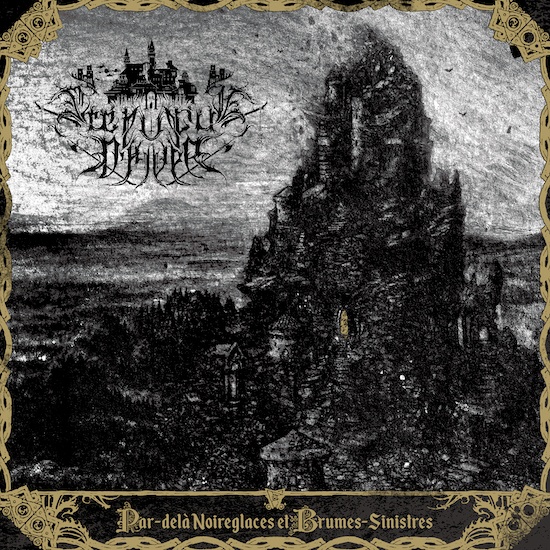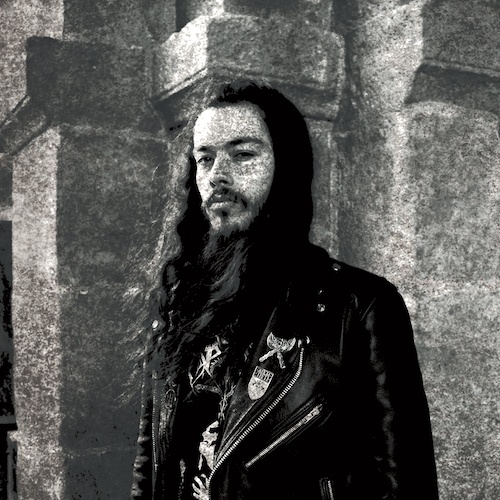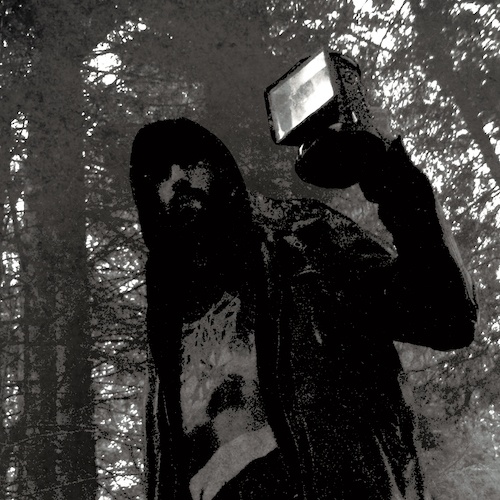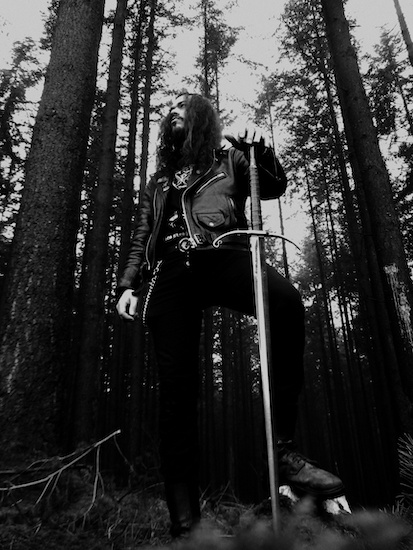
Par-Delà Noireglaces et Brumes-Sinistres, the new album by the French band Crépuscule d’Hiver, is a time machine for the mind. It brings back memories of the more mysterious and fantastical strains of black metal from the ’90s, and also sends the imagination looping much further back, into a medieval age — or at least a long-lost age we romantically imagine it might have been, where even in blood, suffering, and death there was glory to be found, and an appreciation of elegance to be treasured.
The album is substantial in its length and tremendously elaborate in its experiences, produced by a combination of medieval black metal and dungeon synth, among other ingredients. It combines the talents of the band’s alter ego Stuurm, who is the composer, guitarist, keyboardist, lyricist, and principal vocalist, and NKLS, whose contributions as bassist and drummer play a vital role in the music’s overall success. In addition, credit must be given to an array of guest vocalists and guitarists — Hexēnn, Aker, Wÿntër Ärvń, Vettekult, and Spellbound — whose carefully chosen contributions make a richly multi-faceted album even more spellbinding.
The album is being released today by Les Acteurs de L’Ombre Productions, and it’s our pleasure to present a full stream of all the music, with our own thoughts about each of the seven songs.

Stuurm
The stage is set by “Que Gloire soit Nôtre!”, whose union of celestial choirs and an array of keyboard sensations, which range from harpsichord to horn, create a blend of gleaming ambience and shining notes, and an experience that’s stately and bright, mystical and mesmerizing, elegant and elegiac.
With the stage thus set, “Le Sang sur ma Lame” launches hammering drums and gale-driven guitars, intermixed with bounding beats, splendorous sonic streams, and scathing vocals. The song segues from galloping rhythms and head-long melodic ecstasy to stalking cadences and ominous, tension-filled chords, as well as episodes of fluid, seductive guitar melody and murmuring bass accompanied by high singing. The span of sensations extends from organ-toned instrumentals with a dark, gothic air to dancing keyboard arpeggios and neck-popping back-beats, as well as bouts of brutish lurching heaviness and a gorgeous yet melancholy melodic sequence at the end that sounds like trumpets echoing from a high hill. But nearly all of this is overlaid by an atmosphere of mystic wonder and nostalgic yearning.
Vibrant and warlike, “Héraut de l’Infamie” is a vigorous march beneath blazing banners of sound, but there’s also a sense of mounting savagery and dread in the music, a feeling of fear in the searing synth layers and a visceral vitality in the drumwork. Deep, solemn vocals add to an atmosphere of doomed heroism that rises within the heaviest and most harrowing movement of the song, while acoustic notes and horn-like keys give the song an ambience of gracefulness and grandeur.
And thus the opening of “Tyran de la Tour Immaculée” creates a contrast, with hurtling blast-beats, rapidly thrumming bass, and an exhilarating melody. The song does become more measured and head-moving in its pacing, but the sense of joy in the music (underscored by singing) is unrelenting — until it takes a sinister turn into moods of supernatural peril, augmented by scorching goblin snarls and tension-torquing synths. Yet the music’s mood of medieval nostalgia is never far away, and arises here again as the melody lifts and then spreads into a panoramic vision of castle spires through shining mists on distant summits. It’s a glorious and heart-swelling experience, but one with a current of wistfulness and sorrow that sometimes runs through it.

NKLS
And again, the band create a contrast, because “Le Souffle de la Guerre” is solemn and suffering in its opening movement, like the immediacy of grief in the presence of mass death. The drums and bass push the urgency of the music in body-moving directions, and a trilling melody becomes a thrilling yet feverish apparition. As everywhere else on the album, the drum tempos and patterns change repeatedly as the song itself explores changing soundscapes of despair and fervent striving, of mystic memory and heated blood. In its typically wide-ranging journey it reaches from an inspired, sky-bound guitar solo to the rattle of cartwheels across broken ground matched with male choral voices and acoustic strumming.
After a hauntingly sorrowful yet spellbinding dungeon synth composition (“Les Larmes d’un Spectre Vagabond”), this remarkable album closes with the 20-minute title track. Given how far Crépuscule d’Hiver roam over the course of songs half this long, it will come as no surprise to learn that this final journey is especially elaborate, expansive in its reach, and chameleon-like in both its instrumentation and its moods. It draws together all the varying elements of the band’s musical repertoire, with vocal guests again adding to the richness of the tapestry. The aesthetics of medieval black metal and dungeon synth of course play vital roles, but so do performances that have a lot in common with prog-rock. The music is visceral and earthy, and repeatedly hits a fever pitch, but also sends the listener into fantastical dreams of romanticized realms that are both splendid and spectral, and there’s a near-cinematic sweep to the song’s pastoral passages.

In short, the album is an amazing experience, and LADLO is giving it a suitable physical presentation, which includes a handmade wooden box containing only exclusive and limited items.
Enjoy the full stream, and explore the physical and digital offerings through the links below:
ORDER:
https://lesacteursdelombre.net/product-category/bands/crepuscule-dhiver/
CRÉPUSCULE D’HIVER:
https://crepusculedhiver.bandcamp.com/
https://www.facebook.com/crepusculedhiver/

Magnificent.